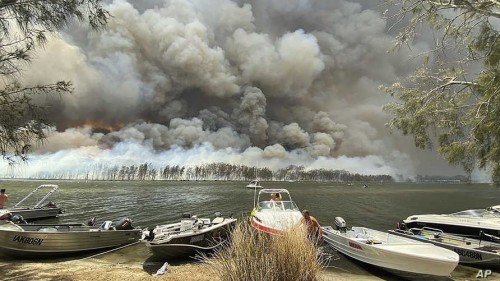Two weeks earlier, the Climate and Health Alliance (CAHA) issued a joint statement declaring that the poor air quality throughout the state of New South Wales constituted a public health emergency. “There is no safe level of air pollution,” the statement cautioned. “The higher the level of pollution, the more hazardous the risks to health. Bushfire smoke is particularly hazardous because of the high levels of tiny particles.”
Now, as hundreds of thousands of acres burn throughout the country, people around Australia are passively inhaling some of the least breathable air on the planet; it's more heavily polluted than that of Shanghai, Beijing, Mumbai, or Delhi. Clouds of smoke are traveling hundreds of miles, enveloping the nation’s major cities and drifting as far as New Zealand. The public health emergency continues to escalate. And according to Dr. Yuming Guo, head of Monash University’s Climate and Air Quality Research (CARE) unit, such toxic air could easily become the silent killer of Australia’s climate catastrophe.
“Any amount of pollution is bad—but the air quality in Australia at the moment is really bad,” he told VICE over the phone. “In the short-term, this kind of pollution could increase the risk of death, hospital admissions, emergency department visits, and ambulance calls. In the long-term it might be associated with shortened life expectancy and the development of diseases—respiratory diseases, cardiovascular diseases, diabetes, dementia—as well as mental health problems, and adverse birth outcomes.”
When Dr. Guo says “short-term” he means the days and weeks during which the pollution is directly experienced; when he says “long-term” he’s talking about months or years down the line. Pollutants can kill people fast and slow. And further exacerbating these health risks is the fact that Australia has, until now, enjoyed a history of clean air.
Dr. Guo explained that while usually the “air quality here is very good,” this ultimately means the Australian people are more vulnerable to air pollution because they haven’t physically adapted to be able to cope with it. “They’re more likely to see those health impacts,” as he puts it. “And the air in Australia got very bad very fast—so that’s also a problem.”
Children and the elderly face a particularly serious risk because their bodies are even less well-adapted, while people with asthma are far more susceptible to suffering the adverse respiratory effects of smoke inhalation. Experts have warned, however, that even relatively healthy people are at risk of developing serious illnesses from prolonged exposure to air pollution.
Tony Bartone, president of the Australian Medical Association (AMA), described the length and density of smoke exposure in Australia at the moment as “a new and possibly fatal health risk that many people within our community have not previously had to face.”
"With denser smoke haze and longer periods that people endure smoke inhalation, there is a much higher risk that previously healthy people will face developing serious illness," he said in a statement, and went on to note that “the mental health burden of this disaster on our communities will be considerable.”
Recent studies have drawn similar connections between air pollution and mental health outcomes, with at least one research paper linking poor air quality to an increased risk of depression and suicide. In that study, a team of researchers from University College London (UCL) and King’s College London found that long-term exposure to fine particulate matter—that is, tiny particles of dust and soot—was linked to depression and anxiety. They also found that short-term exposure to coarse particulate matter—such as those found in dust and smoke—appears to influence the risk of suicide.
"Our findings correspond with other studies that have come out this year, with further evidence in young people and in other mental health conditions,” said senior author Dr. Joseph Hayes in a statement. “While we cannot yet say that this relationship is causal, the evidence is highly suggestive that air pollution itself increases the risk of adverse mental health outcomes."
Dr. Guo echoed these warnings, pointing to a study that looked at the health impacts of the 2014 Hazelwood fire—a blaze in a Victorian coal mine that burned for weeks, blanketing surrounding communities in smoke. Findings suggested that “people exposed to smoke during the 2014 Hazelwood mine fire were still experiencing psychological distress and respiratory symptoms two and a half years later.” Dr. Guo stressed, however, that “everyone in the country should be prepared [for the current bushfire season].”
There are those who are already taking precautionary measures by wearing face masks and staying indoors. Dr. Guo endorsed these methods of harm reduction, but insisted that the masks need to be high quality—an N95 or P2 “respirator” mask that filters out at least 95 percent of tiny particles—and people need to check their houses for air leaks. He further advised that people use high quality air conditioners with filters or standalone air purifiers if possible, and avoid exercising either indoors or outdoors. Those who start seeing adverse health effects should seek out the relevant medicine. Above all else, though, Dr. Guo advises staying out of the polluted air whenever possible.
“People shouldn’t go outside at all in places like Canberra or the badly affected communities, but if necessary they should only go outside for a short distance—to buy food, for example,” he said. “There are fires in all parts of the country, so air pollution is everywhere. It’s going to be a real problem.”

There are parts of Australia where it’s currently a health risk to step outside and breathe. One is the nation’s capital, which last week boasted the most heavily polluted air in the world. At 1 a.m. on New Year’s Day, an air monitoring site in Canberra recorded levels of pollution more than 25 times higher than what's considered “hazardous.”




